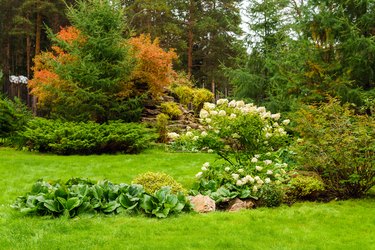
Gently rolling slopes add visual interest and charm to your lawn. Nothing complements a hillside like lush, green grass covering it. Planting grass seed on hills is not much different than planting it on a level surface. The biggest consideration is preventing the grass seed from getting washed away or drying out due to runoff of water from the hill. Simply sow your seed and cover until it grows, and your slopes will be the envy of all.
How to Plant Grass Seeds on a Slope
Video of the Day
Step 1: Loosen and Level the Soil
Loosen the soil, using a rototiller or aerator to penetrate down 2 or 3 inches. Rake over the soil bed to break up large clumps and remove debris such as sticks, stones and roots. Level slight depressions as you go to create an even slope. Push some soil to the side, to use later for covering seeds. Work your way across the area to be seeded.
Video of the Day
Step 2: Apply Starter Fertilizer
Spread a starter fertilizer across the soil bed. Mix the fertilizer in slightly by raking.
Step 3: Mix Seed With Topsoil
Mix your desired grass seed with topsoil. Use two parts seed to one part soil.
Step 4: Seed the Slope
Divide the grass seed mix in half. Seed the slope, using about 4 pounds of seed per 1,000 square feet. Use a mechanical seeder or seed by hand; whichever you prefer. Cross the area, going in one direction and scattering half the seed evenly. Repeat the process, going in a perpendicular direction, until the remainder of the seed is disbursed. Try to make sure the coverage is as uniform as possible so that when the seed sprouts the lawn will grow in fully.
Step 5: Rake and Water
Lightly rake across the seeded slope to cover it with soil. This helps to protect the seed from birds and also ensures good seed-to-ground contact, which will help keep it from washing away. Make sure the soil cover is not too thick — less than 1 inch is sufficient. Follow by watering lightly, avoiding puddles of water. The ground should be moistened, not saturated.
Step 6: Cover Slope for Moisture Retention
Cover the slope to retain moisture and to help hold the grass seed in place across the sloped area. Mulch, straw, or wheat are all good choices in terms of materials, and watering will keep these in place as long as necessary. Try not to use so much that you can't see the seeded area underneath. You want to cover and protect the seed it without smothering it too much.
Another option, particularly for a steep slope, is to purchase and use mesh burlap, cheesecloth or mesh cloth. Mesh cloth will rot in place and prove beneficial to the soil, but other materials must be removed once the grass emerges. Secure these materials with rocks or landscape pins placed around the edges as needed.
Step 7: Water and Fertilize Grass
Water grass daily to twice a day; use enough water to keep the top inch or two of soil moist (not soggy). This is important because it helps encourage root growth, which ultimately means healthy grass. Continue watering the new grass regularly, even after it sprouts and the covering is removed, to help it survive until it is well established. Apply a fertilizer 30 days after planting, if planted in spring, and again in fall. Wait until spring to fertilize if the grass was planted in the fall.